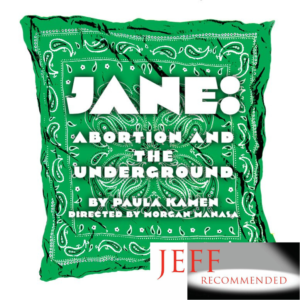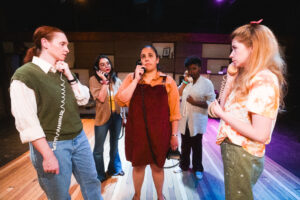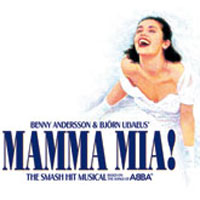
 **** “Jane: Abortion and the Underground”, directed by Morgan Manasa, tells the story of the underground abortion movement in Chicago at a time when abortion on demand was illegal throughout the United States.* The play begins with the movement’s origins in 1965 and details its growth through January 1973 when Roe v. Wade legalized abortion; it ends with the aftermath of the Supreme Court’s Dobbs decision in June 2022, when Roe was overturned and abortion largely made illegal again. Started by several college-aged women, including Heather Booth (Jillian Leff) and Ruth Sergel (Jennifer Mohr), the underground network was initially centered in Hyde Park by the University of Chicago and provided a service for pregnant women from all sorts of social and economic circumstances. They might have been victims of rape or incest. They might not have wanted an additional child in their lives or weren’t yet ready psychologically or financially to have one, or there may have been some defect in the fetus, already detected by a doctor.
**** “Jane: Abortion and the Underground”, directed by Morgan Manasa, tells the story of the underground abortion movement in Chicago at a time when abortion on demand was illegal throughout the United States.* The play begins with the movement’s origins in 1965 and details its growth through January 1973 when Roe v. Wade legalized abortion; it ends with the aftermath of the Supreme Court’s Dobbs decision in June 2022, when Roe was overturned and abortion largely made illegal again. Started by several college-aged women, including Heather Booth (Jillian Leff) and Ruth Sergel (Jennifer Mohr), the underground network was initially centered in Hyde Park by the University of Chicago and provided a service for pregnant women from all sorts of social and economic circumstances. They might have been victims of rape or incest. They might not have wanted an additional child in their lives or weren’t yet ready psychologically or financially to have one, or there may have been some defect in the fetus, already detected by a doctor.
The story, which is a somewhat fictionalized account based in fact, starts with a bold voice from beyond: ostensibly the playwright Paula Kamen (Laura Jones Macknin –V.O.), asking questions of those who once ran the network. “Jane” became its code name. Via flyers or on the Q.T., these women would provide a phone number, and everyone who “manned” the phoneline was given the pseudonym of Jane. Other Janes in this show include Sunny (Caty Gordon), Alice (Elizabeth Macdougald), Judith (Megham Tabor), and Jody (Kristen Alesia), plus Micki (Catrina Evans), one of the few African American women involved. The audience learns how all of these Janes helped secure abortions at low-cost as they eventually acquired skills from medically-trained professionals, such as Dr. C. (Boomer Lusink). We also witness the particularly moving account of one of the clients named Lory (Aleta Sutton), who is repulsed by the unsanitary nature of the room where she received her abortion. Yet, given the same personal circumstances again, she would not hesitate to make the same exact decision.
Among other things, we see the pain of a woman undergoing a D&C without anesthetic: something that a lot of women chose to experience rather than continuing on with their pregnancies. We also see how many weeks along they might have been when those few doctors who did abortions refused to do them; the alternative, then, was for the pregnant woman to experience the physical and psychological pain of miscarriage. We come to understand the lengths that some pregnant women may have undergone in order to terminate their pregnancies on their own, and we are told about the danger of the techniques that they may have used prior to contacting the Janes.
This is a story about the messy truth of what women have had to go through before abortion became safe and legal in 1973. Among other things, I found out that abortion was not taught in medical school, because it was always assumed by (male) doctors that women’s primary role was to be that of wife and mother. The medical schools assumed that a woman was always going to give birth (and wanted to do so) regardless of the circumstances of her pregnancy. It turns out that it was the medics in the Army and paramedics who actually knew about this procedure.
While most of the women involved in this collective could handle the fact that they are facilitating abortions, this was frightening and disturbing to others. We learn about the irony of some Catholics believing abortion to be a sin, yet (according to the play), most of the women who received abortions in Chicago happened to be Catholic. Then there’s the issue of conscience, and we see a Protestant minister Reverend Parsons (Joel Thompson) who, while not explicitly endorsing the work of the collective, believes in his heart that abortionists fill an important need.
The scenic design by Wynn Lee and prop design by Tristan Brandon are marvelous! I loved the multipurpose set with all of the shelving units and knick-knacks throughout, as well as the painted wooden floor that extends into the audience. This is the first thing we see when we walk into this intimate theater. The set turns into a headquarters for the women to meet, a doctor’s office, a woman’s private apartment or house (whose location was being kept secret), and so forth. It is the wonderful lighting by Laura Wiley that allows us to differentiate which setting is which. Wiley also serves as projection designer, such that a number of square and rectangular boxes are incorporated within the shelving units and serve as the backdrop for photos and videos. We see the names of the leaders of the movement projected as well as other information of interest, plus interiors of apartments from that era and historical footage. It was good to see photos of the actual women who protested in favor of abortion rights. However, despite the variety in the projections, I felt that there is too much focus on old videos of the Chicago “L” and the sounds of “L” trains whooshing. (Incidentally, great music and sound design by L.J. Luthringer.) I understand that it is largely poor women who had to travel to all sorts of destinations within the city to receive their abortions and that the providers also travelled by public transportation. However, this story is not about the CTA! Of course, the audience needs some establishment shots in order to ground the action (for after all, this is indeed a Chicago tale). But the “L” footage should be reduced and perhaps interspersed with signage showing the different neighborhoods. Better, fictionalized addresses of secret locations could be projected… and then get smudged away. This could add to the dramatic tension of the story.
In all, this play shines a light on women learning about their own bodies, and we come to realize how and why they chose to abort, given the danger of the procedure from a medical and legal perspective. For some viewers from a certain religious and moral bent, this story may show us the darkest parts of the heart and soul; for others, this story represents women’s liberation and the importance of feminism in preserving and defending women’s reproductive rights. It is also about local Chicago history in the making during the same years as the Vietnam War. Regardless of your religious and moral perspective, the key to this show is that it revolves around the idea of suffering: physically, psychologically, and emotionally. This is disturbing subject matter, and most of the Janes are, at some point, arrested and jailed. Whether you are pro- or anti-choice, this show is important to see. This is not an easy performance to watch but a necessary one to understand.
“Jane: Abortion and the Underground” is playing through October 15, 2023, at the Edge Off-Broadway Theater, 1133 W. Catalpa, in Chicago.
General admission tickets are $20.
$15 for students and seniors
$10 for Thursday Industry nights
Group pricing available on request.
Performance schedule:
Thursdays, Fridays, and Saturdays – 8:00 p.m.
Sundays – 3:00 p.m.
For more information about this show and to purchase tickets, visit
https://app.arts-people.com/index.php?ticketing=imtc or call the Idle Muse Theatre Company Box Office at 773-340-9438.
For general information about the Idle Muse Theatre Company and their other offerings, see: http://www.idlemuse.org/.
*Note that during the time period before Roe v. Wade, the State of Illinois did allow for “therapeutic abortions” such as when a pregnancy jeopardized the mother’s health.
To see what others are saying, visit www.theatreinchicago.com, go to Review Round-Up and click at “Jane: Abortion and the Underground”.






More Stories
“Mamma Mia!” Reviewed by Paul Lisnek
“The Simon & Garfunkel Story”
“Women Beware Women”